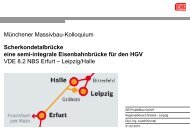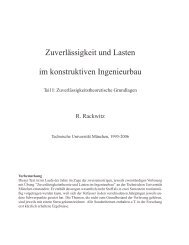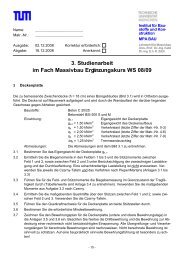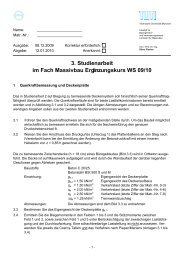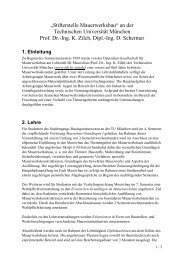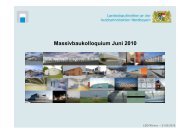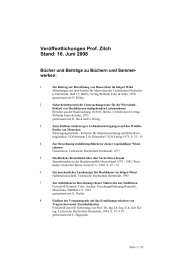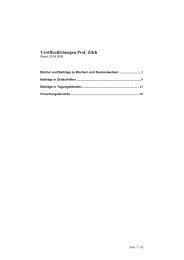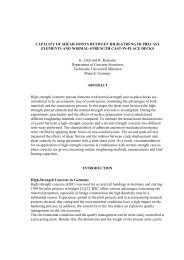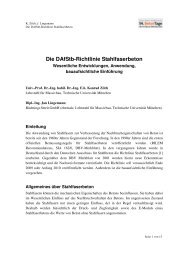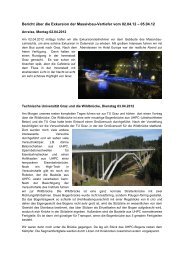Weiher and Zilch - Lehrstuhl für Massivbau
Weiher and Zilch - Lehrstuhl für Massivbau
Weiher and Zilch - Lehrstuhl für Massivbau
Create successful ePaper yourself
Turn your PDF publications into a flip-book with our unique Google optimized e-Paper software.
<strong>Weiher</strong> <strong>and</strong> <strong>Zilch</strong> 2008 CBC<br />
is at 45% for the not exchangeable type (Fig. 4c, Table 1). Presently used external tendons<br />
can also be arranged inside of the concrete section but they are clearly less compact. For pt of<br />
slabs the deviation radii usually are quite large <strong>and</strong> the tendons small – transverse loading of<br />
the steel to the ducts is of less importance. This is quite different when using loop-anchors<br />
with small radii of curvature. There you also have to proof the durability respectively the<br />
resistance of the duct against the loading by the steel members.<br />
a)<br />
b)<br />
c) d)<br />
Fig. 4 Internal tendon types, cross section at high points of the curvature 13<br />
Table 1 Filling ratio of steel for tendons with a prestressing force of about 3 MN<br />
___________________________________________________________________________<br />
Post-tensioning system (F ≈ 3 MN) Ap / Atotal<br />
SUSPA CD-66 (Fig. 3b) 27 %<br />
VBF-CMM D (Fig. 3a) 28 %<br />
VBF compact, one PE-duct (Fig. 4c) 45 %<br />
VBF compact, double PE-duct (Fig 4d) 29 %<br />
VT-CMM D (similar to Fig. 3a) 23 %<br />
VT-CMM KD (similar to Fig. 3a) 25 %<br />
Features of unbonded pt <strong>and</strong> consequences for design <strong>and</strong> construction<br />
Unbonded tendon systems basically differ from bonded systems by their corrosion protection<br />
of the steel. Unbonded tendons are only protected by the components of the tendon:<br />
corrosion protection mass, PE-HD sheathing(s). Bonded tendons using corrugated steel ducts<br />
need the surrounding concrete cover to protect the steel. Mainly, thin concrete cover (e.g. RC<br />
structures built before implementation of the national guideline ZTV-K 80 in 1980 19 ) caused<br />
corrosion of the prestressing steel in the past 1,11 .<br />
BOND / REINFORCEMENT<br />
Because the steel is not bonded to the concrete there is a higher need of reinforcing steel, as<br />
an increase of loading just leads to a small increase of steel stress – but over the total length<br />
of the tendon. In addition to that, the prestressing steel cannot be counted as steel that is<br />
necessary for limitation of crack width. Generally, more reinforcement makes the structure<br />
robust but also leads to higher costs.<br />
4




